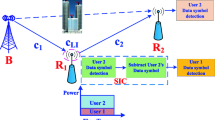Abstract
This paper studies SNR-based TDMA scheduling for a Wireless Powered Communication Network (WPCN). It is composed of a single Hybrid-Access Point (H-AP) which transfers energy wirelessly and collects data, and multiple terminal nodes. For H-AP operating in a half-duplex mode, it is not possible to do data collection from nodes and Wireless Energy Transfer (WET) simultaneously. Since only the first time slot is used for WET, the order of allocation of nodes to TDMA time slots does not affect the performance. On the other hand, for H-AP operating in a full-duplex mode that uses two antennas, one for continuous WET and the other for data collection, the scheduling order affects the performance and fairness. The reason is that a node allocated in a later time slot of the TDMA frame can harvest more energy than the nodes allocated in earlier time slot. Therefore, which order the node should be allocated in is an important issue. In this paper, we investigate the performance and fairness of WPCN when we change the scheduling order that is based on the SNR values of terminal nodes. The simulation results show that scheduling in descending order has maximum fairness, while scheduling in ascending order has maximum sum-throughput but less fairness. Considering the most important problem of WPCN, doubly near-far phenomenon, we conclude that the descending scheduling order can improve fairness significantly because nodes with lower SNR values harvest more energy compared to nodes with higher SNR values.
Access this chapter
Tax calculation will be finalised at checkout
Purchases are for personal use only
Similar content being viewed by others
References
Grover, P., Sahai, A.: Shannon meets Tesla: wireless information and power transfer. In: Proceedings of IEEE International Symposium on Information Theory, pp. 2363–2367, June 2010
Liu, L., Zhang, R., Chua, K.-C.: Wireless information transfer with opportunistic energy harvesting. IEEE Trans. Wirel. Commun. 12(1), 288–300 (2013)
Bi, S., Zeng, Y., Zhang, R.: Wireless powered communication networks: an overview. IEEE Wirel. Commun. 23(2), 10–18 (2016)
Ju, H., Zhang, R.: Throughput maximization in wireless poweredcommunication networks. IEEE Trans. Wirel. Commun. 13(1), 418–428 (2014)
Ju, H., Zhang, R.: Optimal resource allocation in full-duplex wireless-powered communication network. IEEE Trans. Commun. 62(10), 3528–3540 (2014)
Kang, X., Ho, C.K., Sun, S.: Full-duplex wireless-powered communication network with energy causality. IEEE Trans. Wirel. Commun. 14(10), 5539–5551 (2015)
Yang, G., Ho, C.K., Zhang, R., Guan, Y.L.: Throughput optimization for massive MIMO systems powered by wireless energy transfer. IEEE J. Sel. Areas Commun. 62(14), 3565–3577 (2015)
Kim, J., Lee, J.-W.: Performance analysis of the energy adaptive MAC protocol for wireless sensor networks with RF energy transfer. In: Proceedings of International Conference on ICT Converge (ICTC), pp. 14–19, September 2011
Choi, H.H., Shin, W.: Slotted ALOHA for wireless powered communication networks. IEEE Access 6, 53342–53355 (2018)
Acknowledgement
This work was supported by the National Research Foundation of Korea (NRF) grant funded by the Korea government (MSIT) (No. NRF-2019R1A2C1009894).
Author information
Authors and Affiliations
Corresponding author
Editor information
Editors and Affiliations
Rights and permissions
Copyright information
© 2020 Springer Nature Switzerland AG
About this paper
Cite this paper
Yoon, D., Joe, I. (2020). SNR-Based TDMA Scheduling with Continuous Energy Transfer for Wireless Powered Communication Networks. In: Silhavy, R. (eds) Intelligent Algorithms in Software Engineering. CSOC 2020. Advances in Intelligent Systems and Computing, vol 1224. Springer, Cham. https://doi.org/10.1007/978-3-030-51965-0_26
Download citation
DOI: https://doi.org/10.1007/978-3-030-51965-0_26
Published:
Publisher Name: Springer, Cham
Print ISBN: 978-3-030-51964-3
Online ISBN: 978-3-030-51965-0
eBook Packages: Intelligent Technologies and RoboticsIntelligent Technologies and Robotics (R0)




